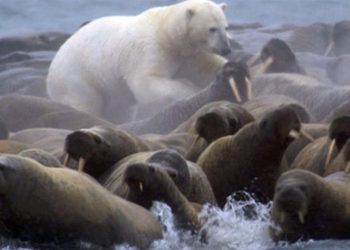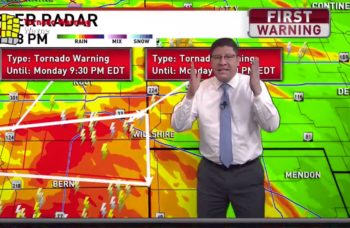
I understand that some people object to hunting and wish more people felt like they do – but this sort of argument is unlikely to sway any but the most gullible.
Norwegian photographer Ole Liodden apparently has a master’s degree in “nature management and environmental policy“.
He takes fabulous polar bear pictures (I purchased one of them, above, for the cover of my novel, EATEN), but his crusade to ban hunting and trade in polar bear products worldwide has to lead him to misrepresent essential facts, which is no way to win an argument.
A National Geographic writer and several polar bear specialists have provided additional spin and used it as an excuse to promote their failed prophesies that polar bears are doomed: “Should polar bear hunting be legal? It’s complicated” (28 May 2019).
- Liodden’s claim that “between 1963 and 2016, an average of 991 bears were hunted worldwide every year” is a gross misrepresentation of facts. Combining hunting totals from 1963 to 1973 (when some years 1,000 or more bears were taken from Svalbard alone) with totals after 1973 (when international protection was put in place) artificially inflates recent hunting numbers and minimizes the wanton slaughter that went on between 1963 and 1973. This kind of subterfuge undermines the author’s entire argument.
- Inuit polar bear hunting is tightly regulated in Canada. The provision to allow a portion of each region’s subsistence quota to be sold to non-Inuit hunters with deep pockets is one of the very few avenues available to inject much-needed cash into northern communities. It does not result in any more bears being killed and Liodden presents no evidence that the system has been abused, despite his fears they might be.
- Polar bears in Canada and around the Arctic are currently thriving and not in imminent danger of extinction.1 The conservation status of ‘threatened’ is based on computer model predictions of what might happen decades from now, not the present situation (Regehr et al. 2016; Wiig et al. 2015).
- The claim that communities are having more trouble with bears because of reduced sea ice is another misrepresentation of fact. It is based on a declining trend in summer sea ice over time that happens to have coincided with increased problems with bears: it does not describe local conditions at particular locations where attacks or problems with bears have occurred. Virtually every time this claim is trotted out to explain particular cases (here, here, and here), it is easily refuted.
- In the 1970s and 1980s, more trouble with bears and more attacks on people were interpreted as evidence of more bears (Crockford 2019; Kearney 1989; Stirling et al. 1977). Since the claim of ‘reduced sea ice’ must be removed from the list of possible explanations, ‘more bears’ is at the top of the list.
- There is no evidence or biological foundation to support Liodden’s notion that hunting prime adult males result in “reverse natural selection” (by removing individuals who may be essential to the survival of the species). In fact, targeting big, older males instead of young ones is likely a benefit to the species because their genes have already been passed on to a multitude of offspring through breeding with many females, while younger males (although perhaps just as healthy and valuable to the species) have not had that opportunity.
- The article refers to the 2007 prediction made by USGS biologists that 2/3 of the world’s polar bears will be gone by 2050 (Amstrup et al. 2007) – despite the fact that we know that prediction has already failed. Sea ice has been at 2050 levels for 12 years without causing polar bear numbers to plummet (Crockford 2017, 2019).
Banning international trade in skins has been defeated three times at previous CITES meetings despite intense pressure from the US Fish & Wildlife Service – a similar motion at 2019 CITES meeting is unlikely to pass at the behest of Liodden.
Using the threat of future polar bear catastrophe due to climate change as an argument to ban aboriginal hunting in Canada or destroy the international market for skins is unfounded and arguably racist, especially since polar bears are thriving despite having lived for the last 12 years with sea ice levels we were assured would be absolutely devastating to their survival.
FOOTNOTES
- In a newspaper article published in Norway by NRK (26 May 2019) that is similar in tone to the National Geographic piece discussed above, Liodden is quoted as saying that “Canada’s polar bear population has declined 30–40 percent since 1973.”
I have not seen his book so I do not know what evidence he uses to back up this bizarre claim. However, I have never seen or heard such an outrageous statement made anywhere before this – not even by the most strident conservation activists or scientists. And as of 2018, Canada still lists the risk level of polar bears as only of ‘special concern’ (not ‘threatened’). If Liodden was misquoted, he needs to demand a correction from the newspaper.
Read rest at Polar Bear Science

















It is so encouraging to get factual science reporting like Dr. Sue produces.
Thanks Doctor for all your great work.
Just like with the Dolphin Safe Tuna and the Save the Rain Forest Camapaigns its a big time scam being carried out by unscupilous persons it all gose hand in hand with the Globalists plans and this underhanded scum sucker who needs to get stranded himself in the wilderness
No Polar bears have died from some minuscule warming but those bullets fired from ski do’s and helicopters now that’s a different story .
If Polar bears were in such distress wouldn’t the eco sensitive northerners stop shooting them ?